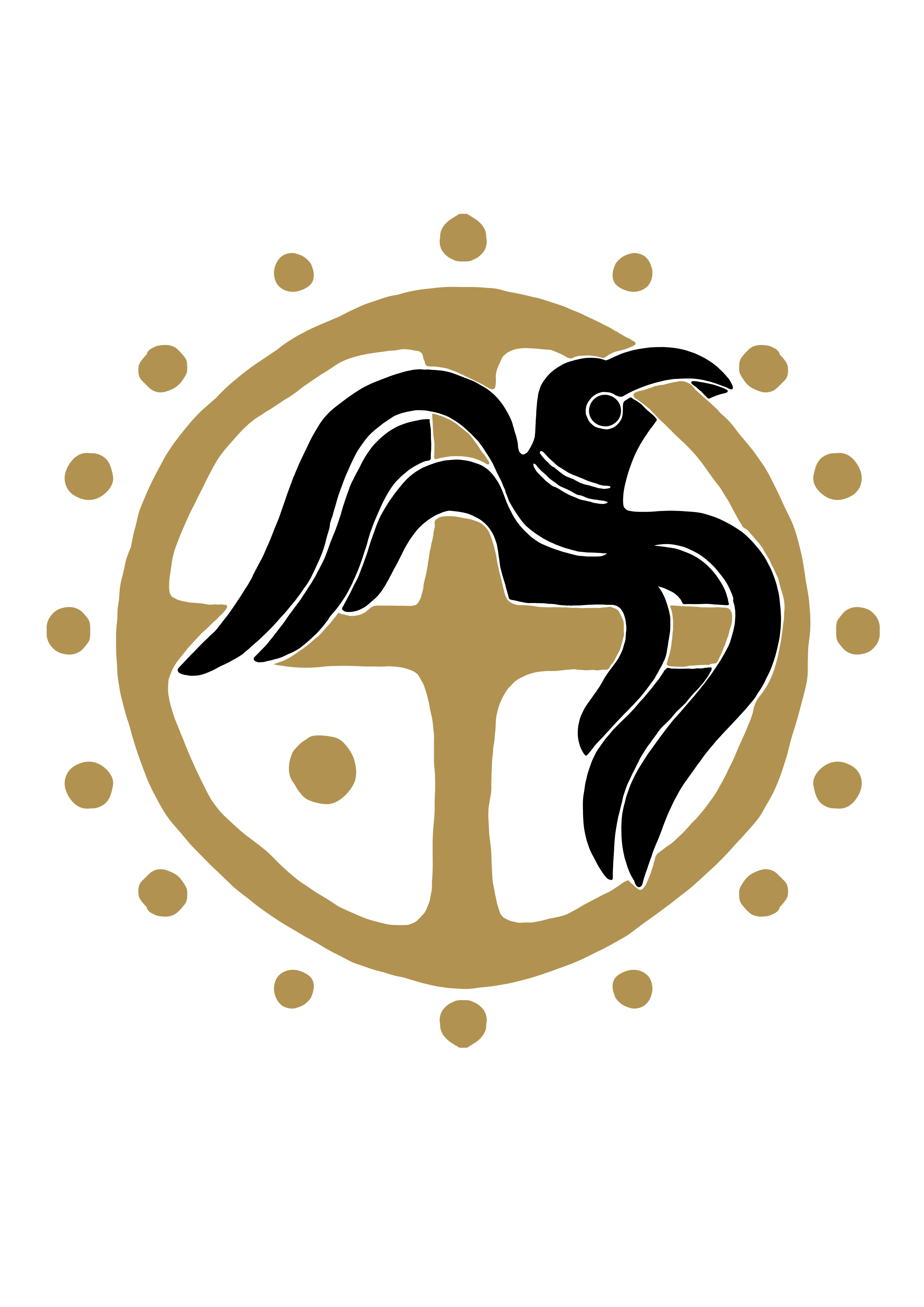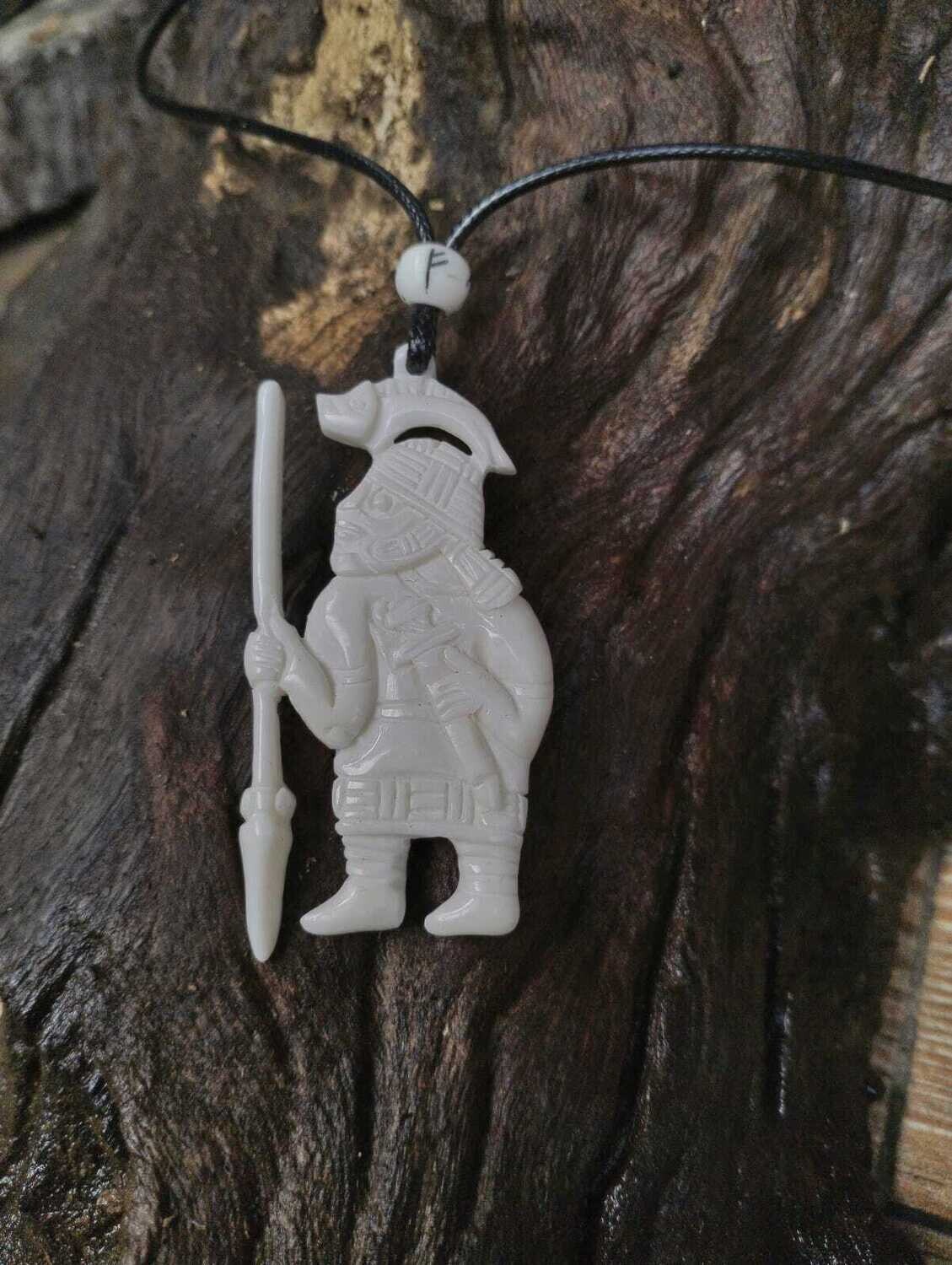Viking Warrior / Berserkr Amulet - Traditional Norse Carvings inspired by the Historical Viking age and Vendel Period art, Bone Hand-Carved
Viking Warrior Amulet - Traditional Norse Carvings inspired by Historical Viking age art (Torslunda Plates with Viking warrior with a sword, spear and wearing a Boar decorated helmet).
Amulet coming with cotton cord and Runic bone bead.
The bone and wood were the most affordable raw materials used to carve and design ornate pieces. A common feature among Viking jewellery were animal designs taken from nature and Norse mythology. Bone jewellery was common among Viking men and women.
Size: 5 - 6 cm / 2.38 inches
The Torslunda plates are four cast bronze dies found in the Torslunda parish on the Swedish island Öland. They display figures in relief, representing what are presumed to be traditional scenes from Germanic mythology. The plates are moulds designed for production rather than display; by placing thin sheets of foil against the scenes and hammering or otherwise applying pressure from the back, identical images could be quickly mass-produced. The resulting pressblech foils would be used to decorate rich helmets of the sort found at Vendel, Valsgärde, and Sutton Hoo. Two of the plates may have been made as casts of existing pressblech foils.
- Archaeological Significance: The Torslunda plates are among the most significant archaeological finds from the Migration Period in Scandinavia. They provide valuable insights into the artistic and cultural achievements of the early Germanic people inhabiting the region.
- Artistic Mastery: The plates are renowned for their exquisite craftsmanship and intricate designs. They feature repoussé (raised relief) decorations depicting various scenes from Norse mythology and Germanic folklore, such as battles, animal motifs, and deities like Odin and Thor. The level of detail and skill demonstrated in their creation highlights the artistic prowess of the craftsmen of that era.
- Cultural and Religious Insights: The imagery depicted on the Torslunda plates offers valuable clues about the religious beliefs, rituals, and cultural practices of the early Germanic peoples. The presence of motifs related to Norse mythology suggests a connection to the religious worldview prevalent during the Migration Period, providing researchers with a deeper understanding of the spiritual aspects of ancient Scandinavian societies.
- Symbolism and Iconography: The motifs found on the Torslunda plates are rich in symbolism, reflecting the cultural values and beliefs of the people who created them. For example, depictions of animals like wolves and horses may have held symbolic significance related to power, strength, and protection, while scenes of battle and conflict could represent themes of heroism, bravery, and triumph over adversity.
- Historical Context: Studying artifacts like the Torslunda plates helps historians and archaeologists piece together the historical narrative of the Migration Period in Scandinavia. By analyzing the designs, materials, and techniques used in their production, researchers can gain valuable insights into the socio-economic, political, and cultural dynamics of the time, including trade networks, artistic influences, and interactions between different communities.
Overall, the Torslunda plates hold immense importance as artifacts that shed light on the rich cultural heritage and artistic achievements of early Germanic societies, while also providing valuable clues about their religious beliefs, symbolism, and historical context.
Four Runes were chosen to be carved on a bead:
- Fehu (ᚠ):Fehu represents wealth, abundance, and material possessions. It is associated with prosperity and success in financial matters.
- Tiwaz (ᛏ):Tiwaz symbolizes victory, courage, and leadership. It represents the energy of the warrior and the ability to overcome challenges with honor and integrity.
- Ansuz (ᚨ):Ansuz is the rune of communication, inspiration, and divine wisdom. It signifies the power of the spoken word and the connection to higher realms of knowledge and understanding.
- Thurisaz (ᚦ):Thurisaz represents chaos, conflict, and protection. It is associated with the forces of destruction and transformation, as well as the need to confront challenges with strength and resilience.
These four runes each carry unique meanings and significance within the runic alphabet, offering guidance and insight into various aspects of life and spirituality.
Material: polished cattle bone. No animal has been injured, as moose drop their antlers from late March to mid-April.
The Viking god Odin was the main god of the ancient Scandinavian Norse people. He is referred to as all father (Alfadir) because he was considered the father of the gods. Odin is also referred to as Wotan (Old German) or Woden (Anglo-Saxon). He was the wisest of the Norse gods and was known for seeking knowledge.
____________________________________
* Recommendations for wear and storage: Avoid protracted heat (saunas, baths, direct sunlight), as well as contact with water and household chemicals.
- #VikingWarriorAmulet
- #NorseCarvings
- #VikingAgeArt
- #TorslundaPlates
- #VikingInspired
- #HistoricalArtifact
- #VikingJewelry
- #BoarHelmet
- #RunicBoneBead
- #AnimalDesigns
- #NorseMythology
- #BoneJewelry
- #VikingMen
- #VikingWomen
- #AncientCraftsmanship
- #VikingHeritage
- #VikingCulture
- #WarriorSpirit
- #NordicTradition
- #VikingSword
- #VikingSpear
- #NatureInspired
- #BronzeArt
- #SwedishArtifact
- #VikingTreasure
- #HandcraftedJewelry
- #VikingHistory
- #AmuletNecklace
- #NorseRunes
- #VikingLife

